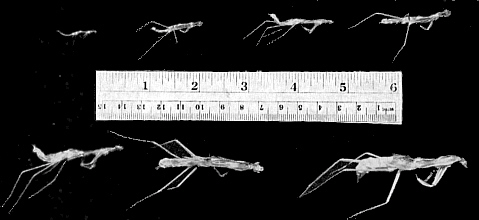There's A Predator in the Bush
Robert George, San Jose, California

|
|
FIG. 72. Mantis sheds many exoskeletons as
she grows during the summer months. |
The heroine of this saga is Paratenodera sinensis, otherwise known as the Chinese Mantis. The plot unfolds in early spring when all activity starts in the garden. The mantis starts her life cycle in a nest called an ootheca, which is a solidified foam egg case, acting as an insulating blanket, keeping extremes of heat and cold from the unborn mantis. When young, she lives mainly on soft-bodied insects, such as aphids and leaf hoppers; when mature, she eats flies, spiders, tent caterpillars, grasshoppers, chinch bugs, crickets, locusts, bees, wasps, beetles, or practically any other insects that come her way. There are more than 1,500 species of mantis in the world, and some 20 native or introduced species in the United States.
This has been our second year of raising these helpful insects, and we have watched closely the activities of these most remarkable creatures. The mantis, alone in the insect world, is able to look over her shoulder. Thanks to a flexible neck, quite independent of the thorax, her head is able to move freely, to turn to the right or left, to bend, and to lift itself. She can direct her gaze; she inspects and examines; she estimates distance, then acts, grasping her prey in her powerful forelegs.
We hatched the eggs in quart mason jars, with cheese cloth over the top to allow air in. The hatching occurred at midmorning and by noon the jar contained some 200 live and active mantis.
The mantis does well on rhododendrons and azaleas. During periods of rain and overhead watering, she will hang upside down under the leaves and wait for the showers to pass. If food is plentiful, she will stay on one plant for many molting periods; when mature, she tends to wander some. We placed them on bushes and trees around our garden. In the weeks and months to follow, we were able to observe and learn much about the habits of the mantis. The ones closest to the house became quite good pets and would accept handouts as offered.
The mantis has an exoskeleton and, as you can see in the photo, the mantis outgrows many exoskeletons in the few short summer months. The last molt leaves her mature and winged. The male, being smaller, does most of the flying and mate searching. After mating, the female will often dispose of her lover by devouring him. She may mate several times and will lay her eggs in one or more oothecae, thereby starting the life cycle once again. She will die in the winter months. As of this January writing, we have one male and one female indoors being hand-fed.
We certainly encourage all who have not tried raising praying mantis to do so. They are a lot of fun and do a great service in the rhododendron garden, ridding the top growth of those hungry grasshoppers who munch on the tender new shoots.